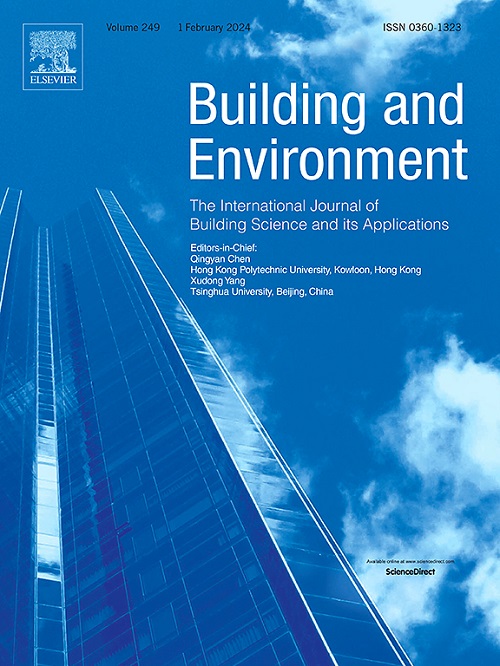研究二维和三维城市结构在季节性地表辐射预算中的作用
IF 7.1
1区 工程技术
Q1 CONSTRUCTION & BUILDING TECHNOLOGY
引用次数: 0
摘要
地表净辐射(SNR)是城市气候系统错综复杂的能量平衡的基石,在研究中备受关注。虽然过去的研究已经阐明了二维城市结构对 SNR 的影响,但在阐明三维(3D)城市特征(包括建筑高度、体量和容积率)之间微妙的相互作用及其对城市景观 SNR 的调节作用方面,仍然存在明显的空白。为了填补这一空白,我们的研究引入了一种定制的物理反演方法,利用 Landsat 8 图像和气象数据集,对城市地区的高分辨率(30 米)季节性信噪比评估进行了改进。我们利用强大的 XGBoost 回归算法和 SHAP 模型,深入研究了受三维城市结构影响的信噪比季节动态。我们的案例研究以北京主城区为中心,强调了反演方法的功效,与原位测量 SNR 值的偏差分别为春季 10.21 W/m2、夏季 8.43 W/m2、秋季 11.55 W/m2 和冬季 9.14 W/m2。与现有文献基准相比,R2 值为 0.81,标准偏差为 23.90 W/m2。从季节上看,信噪比在夏季达到峰值,平均为 642.12 W/m2,其次是春季(590.08 W/m2)、秋季(333.75 W/m2)和冬季(275.93 W/m2)。水体的信噪比始终最高,夏季达到 809.25 W/m2 的峰值,而裸露土地的信噪比最低,平均为 494.58 W/m2。耐人寻味的是,平均高度低于 15 米的建筑在夏季明显减缓了热量增加,而超过 23 米的各种高层建筑则在冬季增强了能量保持,促进了气候变暖效应。通过揭示三维城市结构与 SNR 之间错综复杂的联系,我们的研究结果为有效利用或减缓 SNR 的战略干预措施提供了信息,从而有助于建设更具弹性的宜居城市。本文章由计算机程序翻译,如有差异,请以英文原文为准。
Investigating the role of two-dimensional and three-dimensional urban structures in seasonal surface radiation budget
Surface net radiation (SNR), a cornerstone in the intricate energy balance of urban climate systems, has garnered significant attention in research. While past endeavors have illuminated the effects of two-dimensional urban configurations on SNR, a conspicuous void persists in elucidating the nuanced interplay between three-dimensional (3D) urban features — encompassing building heights, volumes, and floor area ratios—and their modulation of SNR in urban landscapes. Addressing this gap, our research introduced a bespoke physical inversion approach, refined for high-resolution (30m) seasonal SNR assessment in urban areas, leveraging Landsat 8 imagery and meteorological datasets. We delved deeper into the seasonal dynamics of SNR influenced by 3D urban structures, leveraging the potent XGBoost regression algorithm and SHAP model. Our case study, centered on Beijing's primary urban region, underscores the inversion method's efficacy, with deviations from In-situ measured SNR values amounting to 10.21 W/m2 in spring, 8.43 W/m2 in summer, 11.55 W/m2 in autumn, and 9.14 W/m2 in winter. This precision was also reflected in an impressive R2 value of 0.81 and a standard deviation of 23.90 W/m2 compared with existing literature benchmarks. Seasonally, SNR peaked during summer, averaging 642.12 W/m2, followed by spring (590.08 W/m2), autumn (333.75 W/m2), and winter (275.93 W/m2). Water bodies exhibited the highest SNR throughout, peaking at 809.25 W/m2 in summer, whereas bare land registered the lowest, averaging 494.58 W/m2. Intriguingly, buildings with an average height below 15m significantly mitigated heat gain in summer, while a diverse mix of taller buildings exceeding 23m enhanced energy retention in winter, fostering a warming effect. By uncovering the intricate links between 3D urban structures and SNR, our findings inform strategic interventions that can effectively harness or mitigate SNR, contributing to more resilient and livable cities.
求助全文
通过发布文献求助,成功后即可免费获取论文全文。
去求助
来源期刊

Building and Environment
工程技术-工程:环境
CiteScore
12.50
自引率
23.00%
发文量
1130
审稿时长
27 days
期刊介绍:
Building and Environment, an international journal, is dedicated to publishing original research papers, comprehensive review articles, editorials, and short communications in the fields of building science, urban physics, and human interaction with the indoor and outdoor built environment. The journal emphasizes innovative technologies and knowledge verified through measurement and analysis. It covers environmental performance across various spatial scales, from cities and communities to buildings and systems, fostering collaborative, multi-disciplinary research with broader significance.
 求助内容:
求助内容: 应助结果提醒方式:
应助结果提醒方式:


